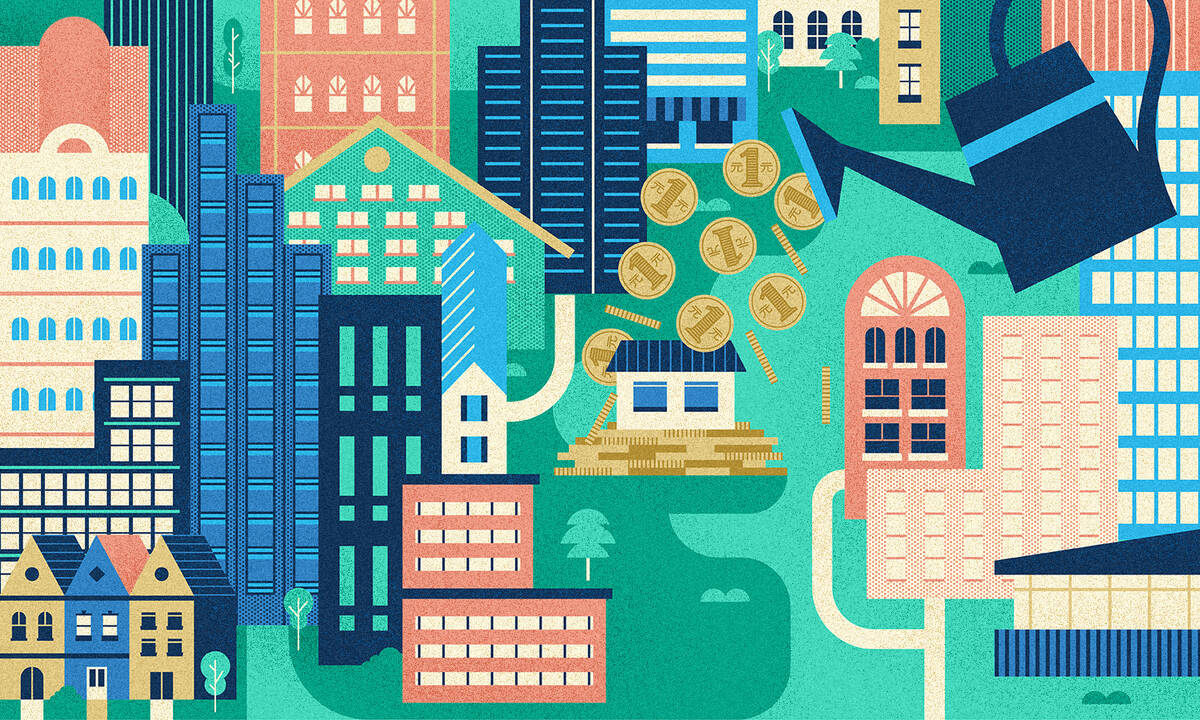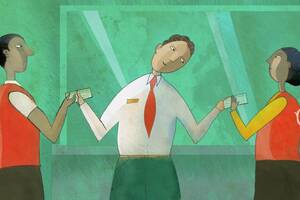It’s not clear how long that will last or how deep it will go, but a recession may be inevitable. So, in the absence of a crystal ball, we turned to Kellogg research into past recessions to see what we could learn to inform our outlook today.
In the years to come, there will no doubt be a glut of research into what, exactly, was happening in our economy today. Was it simply the coronavirus scare? Or were other, less obvious factors at work?
Indeed, when looking back at the 2008 recession, many people point solely to subprime mortgages as the culprit. But research from finance professor Ravi Jagannathan, along with Mudit Kapoor of the Indian School of Business and Ernst Schaumburg of the Federal Reserve Bank of New York, argues that it was far more complicated.
Technological advances and globalization sparked “a huge and rapid increase” in the labor supply from workers in the developing world, especially in China. But thanks to a combination of factors—including a frugal culture and no social security system—these new urban Chinese workers saved their earnings instead of spending them. And because the dollar “remains the effective reserve currency of the world,” their savings flowed straight to the U.S.
Meanwhile, in the U.S., a combination of Wall Street behavior, low interest rates, safe-harbor rules for investing in high-risk debt, and implicit government guarantees to Freddie Mac and Fannie Mae sent investments rushing into real estate. A bubble market ensued, and Americans suffered under the illusion that we could buy whatever our hearts desired. Municipalities’ pockets swelled from real estate taxes. Spending, and borrowing, spun out of control.
The bubble eventually burst, the team asserts, when economic growth in developing countries caused commodity prices to rise. U.S. wages grew modestly, but the price of food and energy grew more quickly. “By mid 2007,” the researchers write, “many subprime households were effectively left with the choice between filling their trucks and fridges or paying their mortgages.”
If history is any guide, in other words, myriad factors other than the actual coronavirus—cultural, political, and behavioral ones—are bound to contribute in complicated and unexpected ways to the ultimate fallout from COVID-19.
Firms backed by private-equity companies may have an advantage when it comes to weathering the crisis.
Research from Filippo Mezzanotti and his coauthors Shai Bernstein of Stanford University and Josh Lerner of Harvard University compared nearly 500 PE-backed firms in the United Kingdom around the time of the global financial crisis to a matching sample of non-PE companies.
They found that while all the firms in both of their samples cut their investments sharply during the crisis, PE-backed firms did so much less than non-PE firms. In fact, the PE firms spent 5.9 percent more than the non-PE ones.
The reason? Private-equity-backed firms may carry more debt, but they also enjoy privileged access to financing via their private-equity investors.
“It’s like if you have rich parents and you lose your job, you can kind of isolate yourself from some of these costs in the short run because you can get money from them and they can help you figure a way out of your issue,” Mezzanotti says.
Sitting on a really good business idea? What would it mean for your startup if you founded it during a recession?
We know that recent graduates who begin jobs during an economic decline tend to earn less than those who start their careers in a booming market. And the difference can persist for more than a decade. Kellogg’s Sara Moreira wondered: Could economic circumstances have similar effects on startups?
Using data from the Census Bureau, Moreira did find significant ramifications for businesses, depending on the economic climate in which they were started.
Businesses started during recession years began smaller than those created during boom periods. And they remained smaller throughout their lifetimes, growing 1.4 percent more slowly than businesses that started in more fortuitous times.
“The key here is the persistence of this effect on startups,” Moreira says. “It really says there’s something different about how economic conditions affect a business at entry.”
Why? Her work suggests that during a recession or economic downswing, firms have greater difficulty establishing customer reputation and brand awareness, which limits their ability to grow later on.
Consider a software company launched during the boom year of 2005. It would have captured a certain customer base. In later years, word of mouth, reviews, returning customers, and a positive perception of the company’s brand would further boost sales. A competitor that launched during the 2008 recession, however, would have experienced lower demand in the first year thanks to fewer consumers. In later years, not as many customers would be likely to try its product, so the product would remain less well-known, and sales would never pick up in the same way. That lower demand could persist for years because of how the brand is perceived.
“If the two software products are exactly the same and people don’t really care about brand A versus brand B, they have a common demand,” Moreira explains. “But that is not the case. Consumers perceive brands differently—and consumer demand is a very important driver of many differences between firms.”
There were many different attempts to ease the impact of the 2008 recession. How well did those work?
Jacopo Ponticelli, an associate professor of finance, tackled one piece of this question: How successful was China’s aggressive stimulus program, which roughly doubled the amount of money that Chinese banks loaned to households and firms?
Often, he explains, a larger credit supply can lead banks to start extending loans to subpar companies. While that may bolster job opportunities in the short term, it can also keep inefficient companies afloat, hurting economic growth in the long run.
To study this, Ponticelli collaborated with Lin William Cong of the University of Chicago, Haoyu Gao of Renmin University of China, and Xiaoguang Yang of the Chinese Academy of Sciences. The team analyzed detailed loan data from the China Banking Regulatory Commission from 2006–2013, as well as information about individual firms from the National Bureau of Statistics of China.
While loans were not concentrated in any particular sector of the economy, some patterns emerged.
For example, a disproportionate share of new credit began flowing to less productive firms, whether state owned or private.
It might be reasonable to prop up less productive companies to preserve jobs during a recession, Ponticelli acknowledges—however, the fact that this effect outlasted the recession is “a little bit worrisome.”
While the researchers did not explicitly look at whether the Chinese economy suffered as a result of this reversal, economists agree that systematically misallocating loans can drive out productive firms in the long term. As such, Ponticelli sees the study as a cautionary tale for other countries considering using an influx of money to sustain a nation’s economy during a recession.
While there is no general formula for how governments should respond to economic crises, Ponticelli suspects that it might be better to introduce stimulus programs more gradually. In China, “there was a rush to try to avoid, at all costs, negative numbers in terms of GDP growth,” he says. “Maybe a more prudent approach at the beginning would have helped.”
In December 2008—and again today—the Federal Reserve lowered interest rates as close to zero as possible. At least in 2008, that didn’t stop the recession. So what tools remain for policymakers to fight a downturn?
Scott Baker, an associate professor of finance, along with Leslie McGranahan of the Federal Reserve Bank of Chicago, Brian T. Melzer of Dartmouth College, and Lorenz Kueng of the Università della Svizzera italiana, tested the effectiveness of one possible—if counterintuitive—alternative: announcing that a sales-tax hike is on the horizon in order to encourage consumption before the tax takes effect.
“The idea is that if demand is low, one way to try to get out of the recession is to pull forward spending from the future,” Baker says. “Saying that you will increase taxes in the future on consumer goods could incentivize people to do that spending now rather than in the future, when taxes will be higher.”
The researchers suspected that people might be most motivated to pull forward their spending by a larger amount of time when they are buying “a more durable good, a bigger-ticket item,” Baker says. “Durability matters because, if an item depreciates or degrades, it makes less sense to buy early or to stock up on it.”
Moreover, from an economist’s point of view, larger expenditures mean more money in the economy during downturns, and therefore they have a greater capacity to counteract a recession.
So the researchers looked at purchases of cars, examining a timeline of state-by-state sales-tax changes alongside time-specific data on car sales.
They found that auto sales rose by an average of 8 percent in the month preceding a sales-tax hike for every 1 percentage point increase in the tax.
Most surprisingly to Baker, the effect was twice as strong during recessions—a whopping 15 percent increase in sales for every 1 percentage point tax increase—suggesting that this technique could indeed be used to stimulate the economy when all else failed.
However, the consumers most likely to get a jump on a purchase were the highly creditworthy; those with the highest 20 percent of credit scores were twice as likely to beat the tax hike as those in the lowest 20 percent.
So the success of a policy like this would be partially contingent on widespread access to credit. “If everyone is credit-constrained, it’s going to be difficult to bring forward spending,” Baker notes.
Additionally, Baker says that the success of a sales-tax announcement would depend on the size of the tax. In the study, most of the anticipatory spending was constrained to just one or two months before a sales-tax change—not sufficient to offset a recession. But Baker and his coauthors argue that if the boost to the tax were considerably larger, the spending impact would likely be seen across a longer span.
And, of course, Baker acknowledges that a new tax policy—especially in the midst of a recession—would likely face strong political pushback.
However, Baker says, economists have suggested ways to raise taxes without slowing down a recovering economy. “You would hike sales taxes by a large amount but also send out a check to everyone in the country—like the tax rebate checks issued in 2001—so that, on average, there is no increase in net taxes paid,” he says. “You’d get, say, a $500 check in June so you can spend more now. Then sales taxes go up the following January for 18 months, and those taxes basically recoup that $500 over time.”



